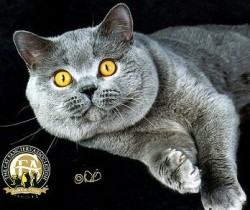History
The British Shorthair is one of Britain’s first pedigree cats – at least a hundred years old – and one of the most popular breeds in the UK.
These cats are said to link back to Britain’s ancient street cats, whose ancestors arrived with the Romans between the first and fourth century, and these then bred with wild native cats. Later, they were bred with Persian cats to improve the coat thickness.
The breed standard was drawn up in 1871 and the development of a shorthair pedigree cat began. The breed has changed very little over the years and its popularity continues to grow.
Appearance
These are sturdy, dense-coated, purring, teddy bear cats with large round eyes. Another thing that draws people to the British Shorthair is their size. Although they are not huge like the Maine Coon, they are a medium to large cat. They are a slow maturing breed and do not reach their full size until three years of age. Mature males average 9 to 17 pounds, and mature females average 7 to 12 pounds. Although most people think of them as being blue cats, they come in a number of colors and patterns.
The breed’s good-natured appearance and its smile, make it a frequent media star, notably as the inspiration for Tenniel’s famous illustration of the Cheshire Cat from Alice’s Adventures in Wonderland, and in Walt Disney’s 2010 Alice in Wonderland, directed by Tim Burton.
Personality
This breed is noted for its intelligence, loyalty and extending affection in a dignified manner. British Shorthairs are relatively calm cats when they mature. They are easygoing in nature and talk infrequently. Very affectionate, they become quite attached to the people they own. British Shorthairs are easily trained and very adaptable. They seem to get along well with all human members of the household, regardless of age, but are usually not fond of being carried. Pets of all kinds have been kept with British Shorthairs, including dogs of all sizes, rabbits, and birds.
Grooming
A good once a week combing with a steel comb is recommended to maintain its luxurious plush coat. We recommend combing twice a week or more during the spring and fall shedding seasons.
Information was used from the following sites:
http://www.cfainc.org/Breeds/BreedsAB/BritishShorthair.aspx
http://en.wikipedia.org/wiki/File:Cheshire_Cat_Tim_Burton.jpg
http://www.yourcat.co.uk/Cat-Breed-Profiles/british-shorthair-cat-breed-profile.html


